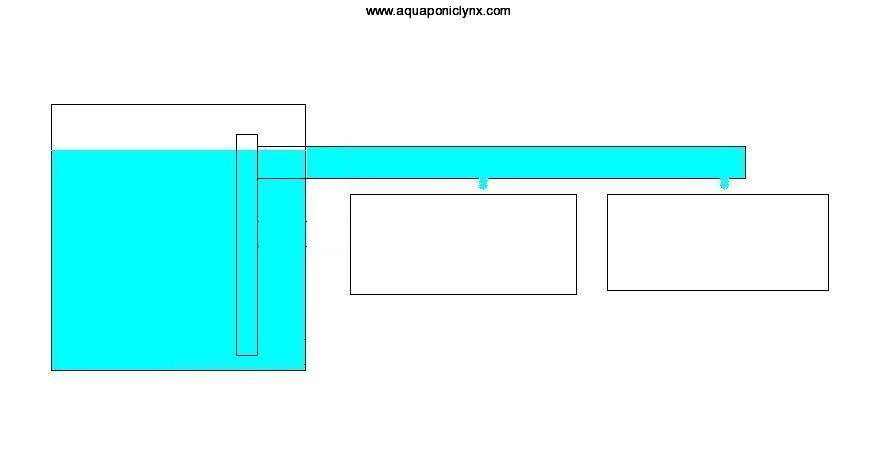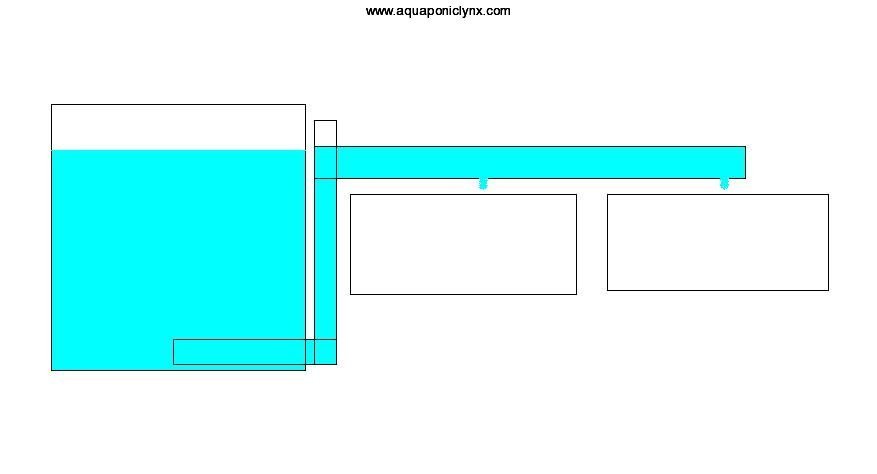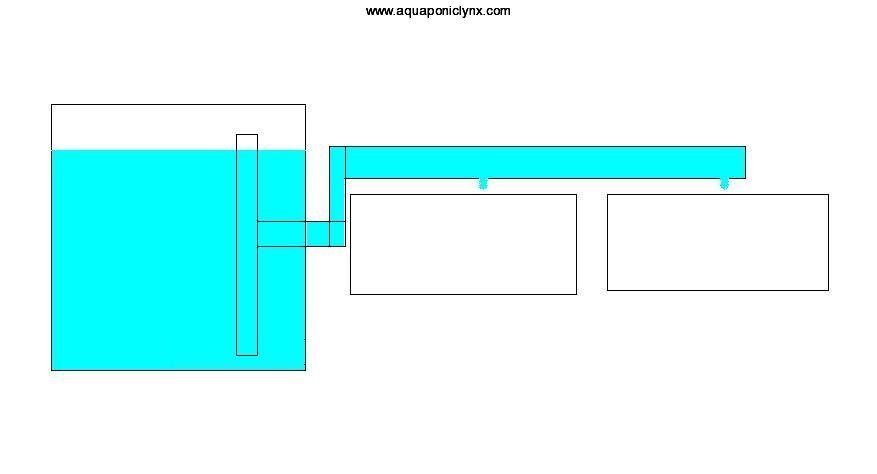How do make a failproof flood/drain system, when my growbed is UNDER my fishtank?
Hi everyone
This is my first post in this forum, and i'm completely new to aquaponics,
so bare with me :)
I have been using the last couple of weeks to come up with a small scale system.
About 6.6 gallons.
This is my quite primitive miniature model, but it gives an idea of where i'm going.
The blue cardboard paper is the fish tank, (i'm thinking about placing the fish tank on a
transparent box so the bottom of the fishtank, levels with the top of the growbed (the black cardboard paper), the growbed will be some sort of plastic tray, the thing on the left is going to be a mountain with a waterfall, in the right side of the picture a pile of stones wich is there to conseale the corners of the fish tank (here i want plants instead of stones i think).
The growbed will be about 5.9 inches high
The fish tank will be about 19.7 inches in lenght, 9.8 in width and 7.8 in height.
I'm thinking that maybe i can grow some kind of ivy, that doesnt have to deep roots, and it will
be sorrunding the fishtank, looking like a forest floor.
In the right side of the fishtank i will drill a hole or two, attatch some plastictubes and place them
in the growbed ( plastic tray),where the ivy will be, make some holes in the tube, and the water then feeds the plants.
Then i'm thinking, that i can place a pump IN the growbed (plastic tray) that will pump the water up to the top of the mountain, and the water will then slide down into the fish tank and give the creatures a bit of oxygen.
But what do i do when the pump suddently breakes down, the plastic tube from the pump breaks loose and the growbed gets full of water? I have the fishtank IN the growbed, so how can i make this system so failproof as possible? I just cant seem to figure this out. help...
Maybe drill some holes in the top of the growbed, attatch some plastic tubes, and stick them out my window or leed into my toilet...Hmm... maybe not :)
The creatures in the fish tank probably is going to be some prawns, snails and a couple of fish that can thrive in 6.6 gallons of water.
I would like to have this whole setup, standing on top of my bookshelf, so i can be looking at a miniature model of a forest, a waterfall, and in the middle, a small lake, but i don't want want all my books wet, if the growbed suddently gets flooded!
So please tell me if you have ANY idea how tomake the simplest... flood and drain system (is that the right term..?) with this setup and i'll be the happiest man on the planet :)
Since i'm at it, i have been wondering about having plants, sand, stones, wood in the fishtank. What are my possibilities, if i want to give the fish some hidingplaces, but still not mess up the quality of the water?
Tommy
Tags:
Replies to This Discussion
-
Permalink Reply by Ryan Chatterson on October 15, 2011 at 5:26am
-
It is possible! Ive grown full heads of Broccoli in 4" gravel beds so a small Ivy plant shouldnt be a problem.
-
Permalink Reply by Tommy Denda on October 15, 2011 at 6:29am
-
Hey Ryan.
Well there you have it. You have done it with broccoli, and then i surely can do it with ivy.
I changed my post a bit, since your reply answered my question, in the first version
of the post. Thanks a lot :)
-
Permalink Reply by TCLynx on October 15, 2011 at 6:51am
-
You will have to set up the plumbing between the fish tank and grow bed such that the fish tank can only drain down so far.
Here are some useful diagrams that might help you visualize plumbing a little better.
You would set up so that the fish tank has a constant level and then you add some water to the grow bed so the pump has something to pump and when you pump that water it moves around but there isn't enough water to "overflow" your grow bed. Now if the fish tank fails or the plumbing through it breaks you might have a problem but there is only so much you can to to make things fail safe. Perhaps you get a mortar tub and set the whole thing in that as a containment basin in case of trouble.
-
Permalink Reply by Tommy Denda on October 15, 2011 at 7:23am
-
Thanks Tcl
Which one of the diagrams would resemble the method you are writing about?
I'm trying to visualize it but i'm still so new at this, that i really need to have
it explained so simple as possible.
Do you mean that i should drill the hole/holes in top of the fish tank instead of
drilling it lower, so if it goes wrong the whole fish tank won't empty but just
the water over the drilled hole? Makes good sence if that is what you mean.
Haha, now i think of it, it's actually quite simple :)
Then i will need some current in the water, to make sure the waste from
the fish and the prawns, gets circulated in the fishtank. A small
air pump would do the trick, and then the creatures will get enough
oxygen, even though the fish tank has a large surface.
Thanks for the tip :)
-
Permalink Reply by TCLynx on October 15, 2011 at 7:37am
-
No particular picture there would match your design really. It is the SLO drains that should be of most interest to you.
However you don't have to put them at the top of the tank. The high water level is the highest you can put the hole for a slow drain but you can also have the hole lower and adjust the water height with plumbing as well.
Here is another link that has more diagrams and some of them with more explanation attached
The SLO drain and Bypass are some of the most important plumbing tips in aquaponics along with the need to make sure your gravity drains and SLO (slo stands for solids lifting overflow) drains are bigger than you think you need. If your tiny pump uses 3/8-1/2" tubing then you should probably use 1" pipe for your slow drain from the fish tank. A good bulkhead fitting or uniseal for going through the fish tank will make the hole less likely to leak and a 1" uniseal doesn't cost that much, the hole saw bit to cut the hole for it will cost more.
-
Permalink Reply by Tommy Denda on October 15, 2011 at 8:22am
-
Haha. Cool. Well, i have very little money, and no stuff to make it from, so i
need to make sure i have it figured out before i start using money.
By the way...
If i calculate how much water will go from the fish tank into the growbed,
and i make a small container and place it IN the growbed, in the space between the
fish tank and the one side of the growbed, make a crack in this container
just under the top edge of the growbed, make sure the volume of the container
is just at bit higher than the maximun amount of water than can go from the fish tank
into the growbed, havent i then made a system that cant make my books wet?
If everything goes wrong, the container just gets full of water, and i empty it
into the fishtank...
Have i missed anything, because it sure seems too simple...?
-
Permalink Reply by Harold Sukhbir on October 15, 2011 at 10:51am
-
Hi Tommy,
Really cool idea!. A small airlift pump, meshed balancing holes in FT, at least equal media to fish tank volume, should be great. Looking forward to seeing it completed.
-
Permalink Reply by TCLynx on October 15, 2011 at 12:25pm
-
I don't know about putting another container in the grow bed.
I think you will make it all safer by putting the whole thing in a mortar tub as a containment basin if you have any spills.
I don't think you can manage flood and drain with the system you are proposing, it will be more like a constant flood set up with a little water fall and some ivy.
-
Permalink Reply by Tommy Denda on October 15, 2011 at 12:29pm
-
Cool, thanks. Sounds interesting. I'll have a look at the diagrams :)
TCLynx said:
No particular picture there would match your design really. It is the SLO drains that should be of most interest to you.
However you don't have to put them at the top of the tank. The high water level is the highest you can put the hole for a slow drain but you can also have the hole lower and adjust the water height with plumbing as well.
Here is another link that has more diagrams and some of them with more explanation attached
The SLO drain and Bypass are some of the most important plumbing tips in aquaponics along with the need to make sure your gravity drains and SLO (slo stands for solids lifting overflow) drains are bigger than you think you need. If your tiny pump uses 3/8-1/2" tubing then you should probably use 1" pipe for your slow drain from the fish tank. A good bulkhead fitting or uniseal for going through the fish tank will make the hole less likely to leak and a 1" uniseal doesn't cost that much, the hole saw bit to cut the hole for it will cost more.
-
Permalink Reply by Tommy Denda on October 15, 2011 at 12:50pm
-
Hmm. i don't understand why i can have the hole in the fishtank, at a low level,
and still make the system so failproof as possible....
I'm thinking that the water in the fish tank placed OVER the hole,
have a risk of ending on the floor. Så if i drill a hole 2 inches below the
top water level, and i calculate the amount of water from the hole to
the top water level to be 1.5 gallons, then 1.5 gallons of water have a risk
of ending up on the floor, but not if i place a small container in the growbed
that can hold these 1.5 gallons of water.
Drilling the hole at a low level in the fishtank, does it have something to do with
the pressure from the water? The lower the hole is placed, the more pressure
the water coming out will have, and maybe this will prevent the pipes/tubes
from clogging?
Sorry for my newbie questions :)
Tommy
TCLynx said:No particular picture there would match your design really. It is the SLO drains that should be of most interest to you.
However you don't have to put them at the top of the tank. The high water level is the highest you can put the hole for a slow drain but you can also have the hole lower and adjust the water height with plumbing as well.
Here is another link that has more diagrams and some of them with more explanation attached
The SLO drain and Bypass are some of the most important plumbing tips in aquaponics along with the need to make sure your gravity drains and SLO (slo stands for solids lifting overflow) drains are bigger than you think you need. If your tiny pump uses 3/8-1/2" tubing then you should probably use 1" pipe for your slow drain from the fish tank. A good bulkhead fitting or uniseal for going through the fish tank will make the hole less likely to leak and a 1" uniseal doesn't cost that much, the hole saw bit to cut the hole for it will cost more.
-
Permalink Reply by TCLynx on October 15, 2011 at 2:42pm
-
Here are a few pictures of how you can arrange SLO drains to all have aprox the same water level in a fish tank but the holes in the fish tank are at different levels. While it is true that the first one will have least chance of loosing water in case of some failure of the plumbing, it is also the least flexible in that if you put the hole too high close to the rim of the fish tank and the plumbing is too small and your pump too powerful you run the risk of water flowing over the top of the fish tank.

The next one with the hole at the bottom does have the danger that if your plumbing comes apart after the fish tank or if the material around the hole is weak and you stress it by putting excess pressure on the fittings where they attach to the tank, It could fail but for some situations it will also provide the easiest means for draining a large tank.

The last one will be the most flexible since you don't have to know the exact height the water needs to go to before you drill the hole since it will allow you to adjust the water height using plumbing but again, if the plumbing fails you loose some of the water that is above the hole.

This may be why most indoor systems are simple systems where the grow bed is above the fish tank and you simply pump from fish tank up to grow bed and it drains back down to fish tank. Water level in fish tank fluctuates to flood and drain the grow bed.
To try and invert it all and have the fish tank sit in the grow bed means that you have to pump from the grow bed to the fish tank. If you were to try to place an overflow container in the grow bed to be able to catch any spillage from the fish tank, that container is likely to try to float. Or were you talking about a container bigger than the fish tank that the fish tank would sit in?
I still think a better safeguard might be to set the whole thing in a mortar tub (they don't cost that much.)
© 2025 Created by Sylvia Bernstein.
Powered by
![]()
